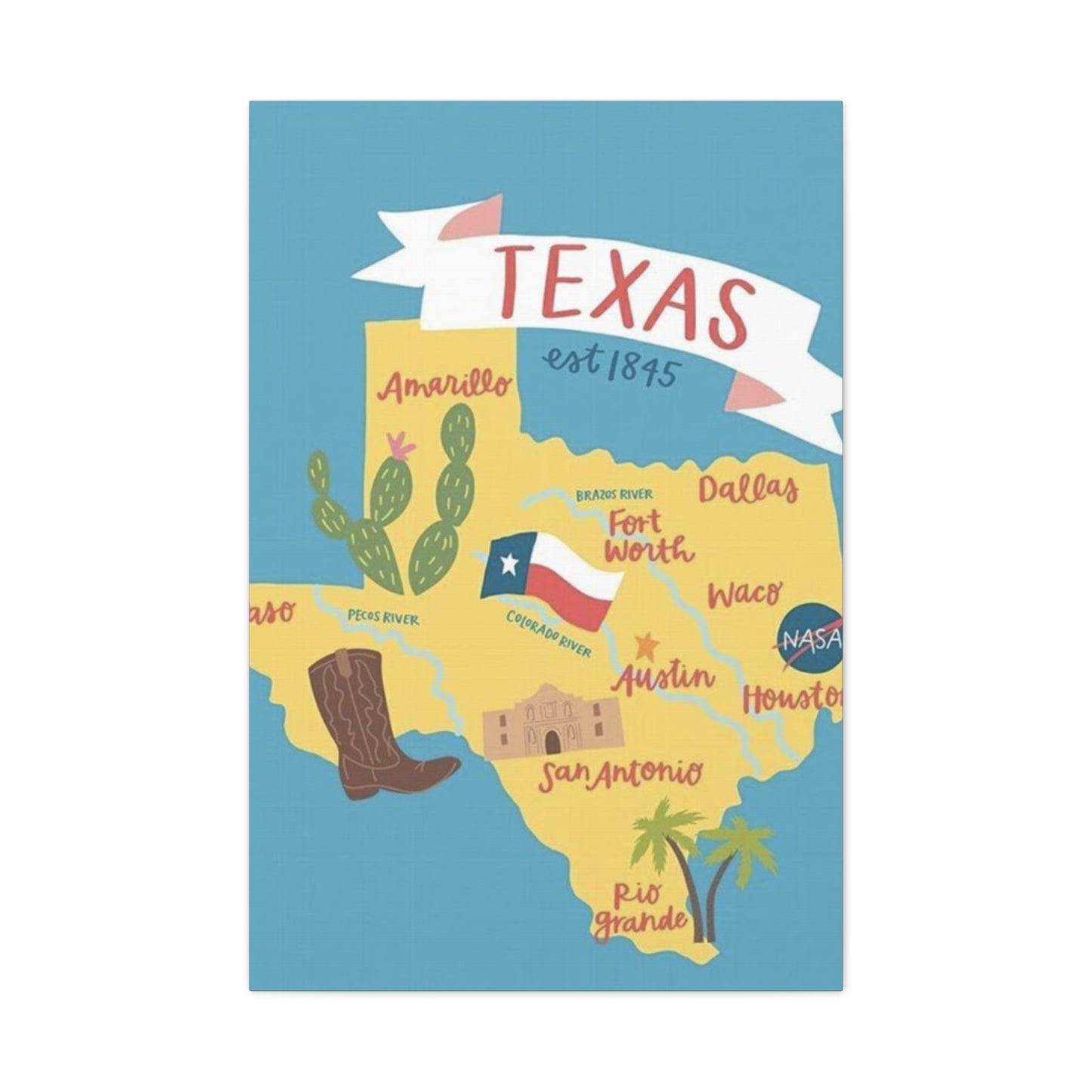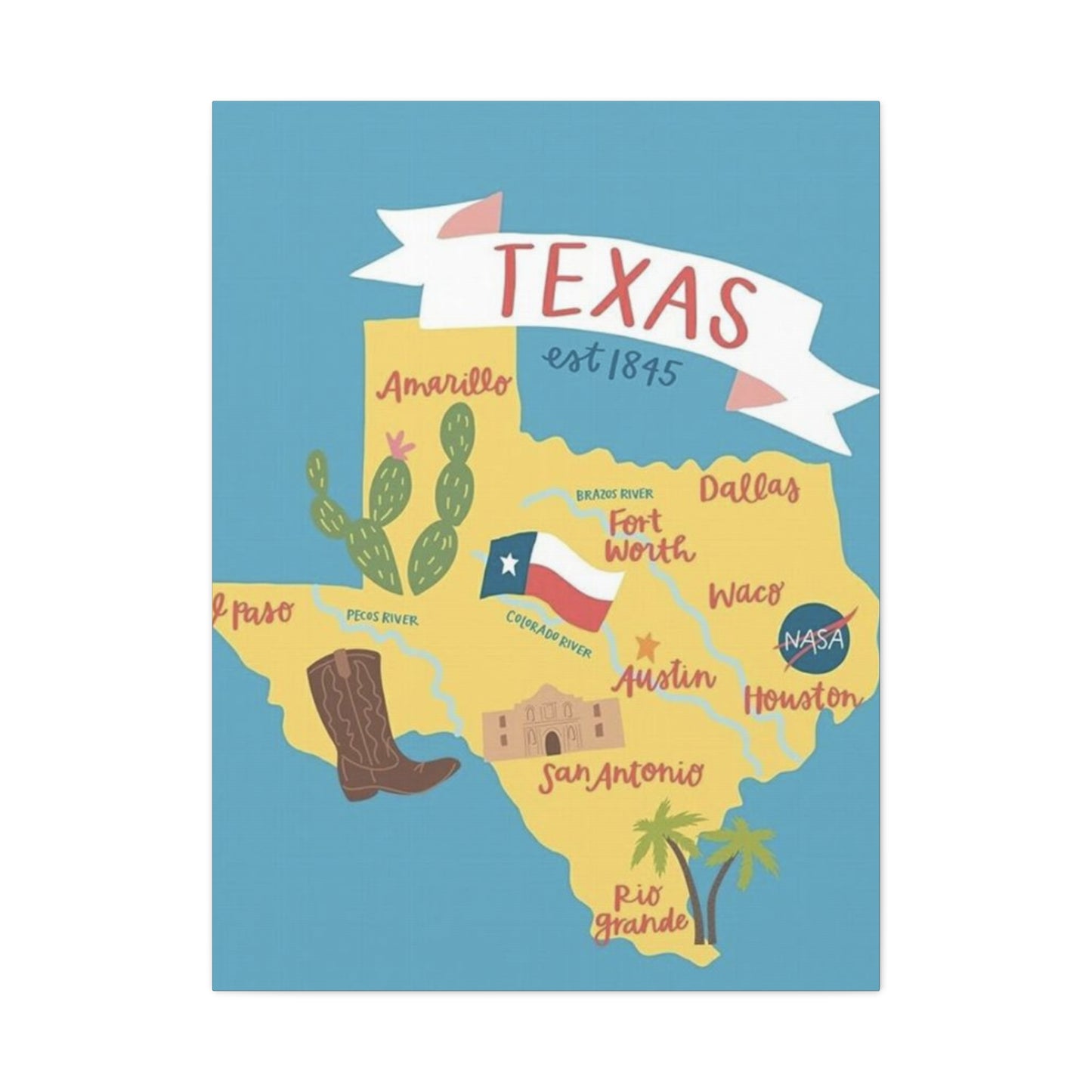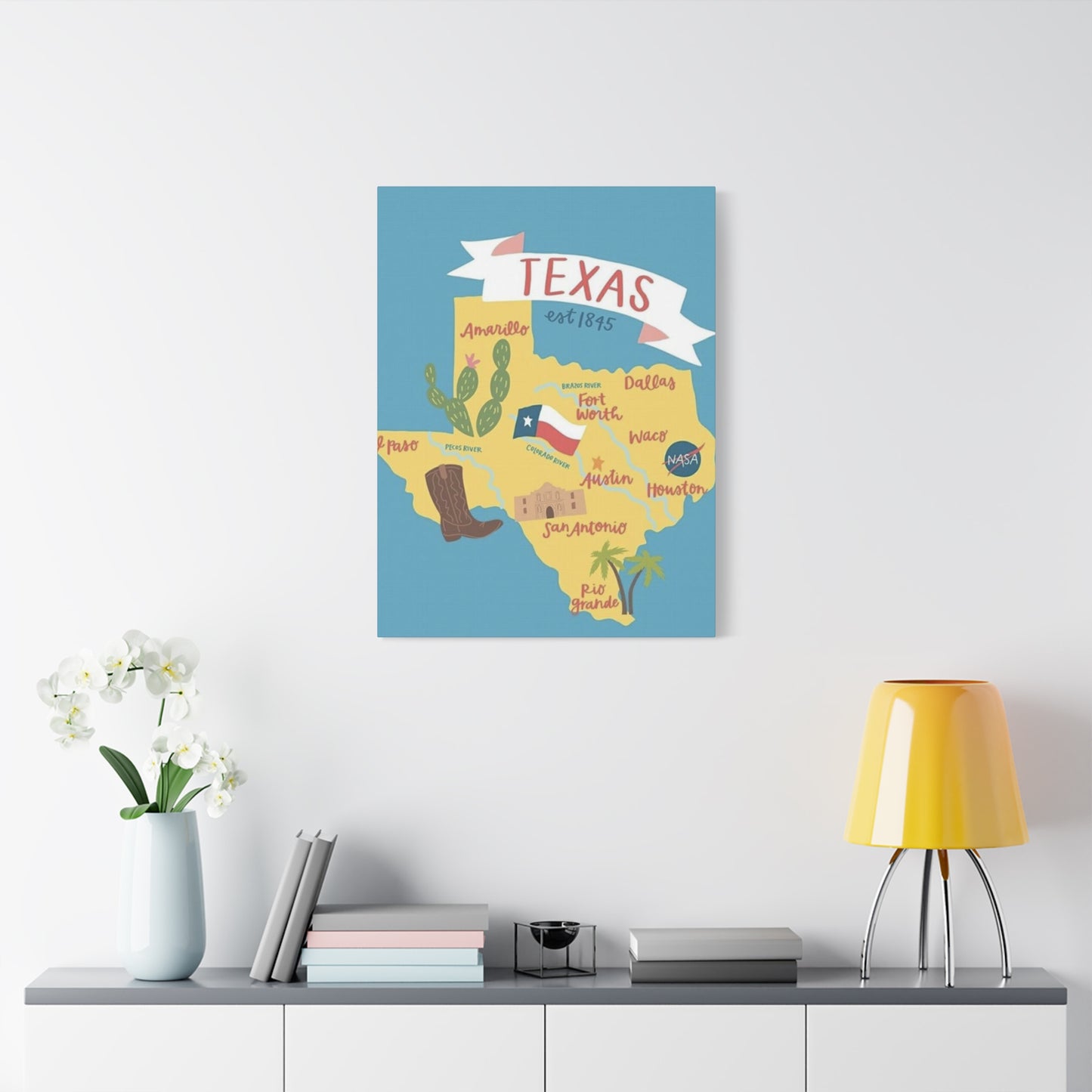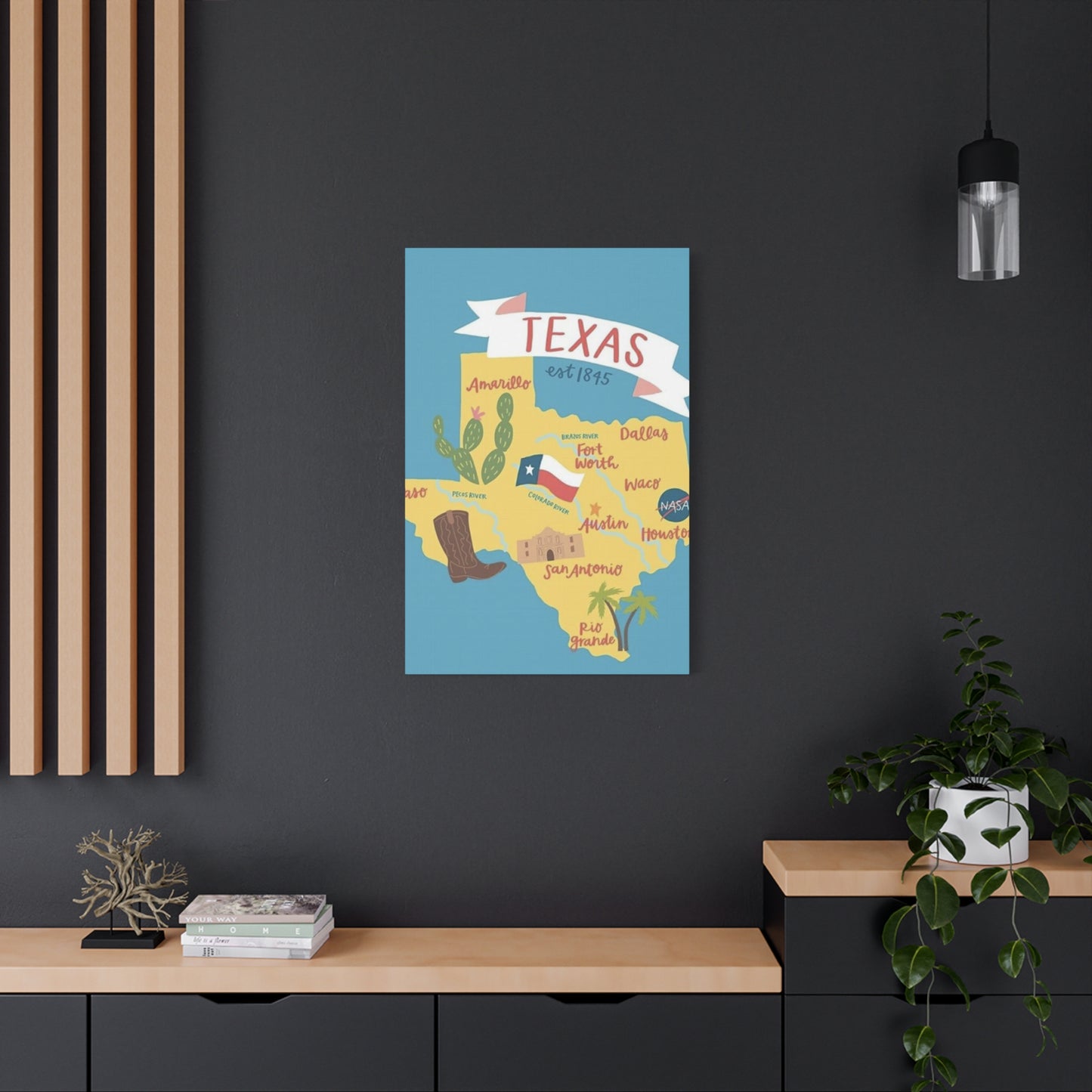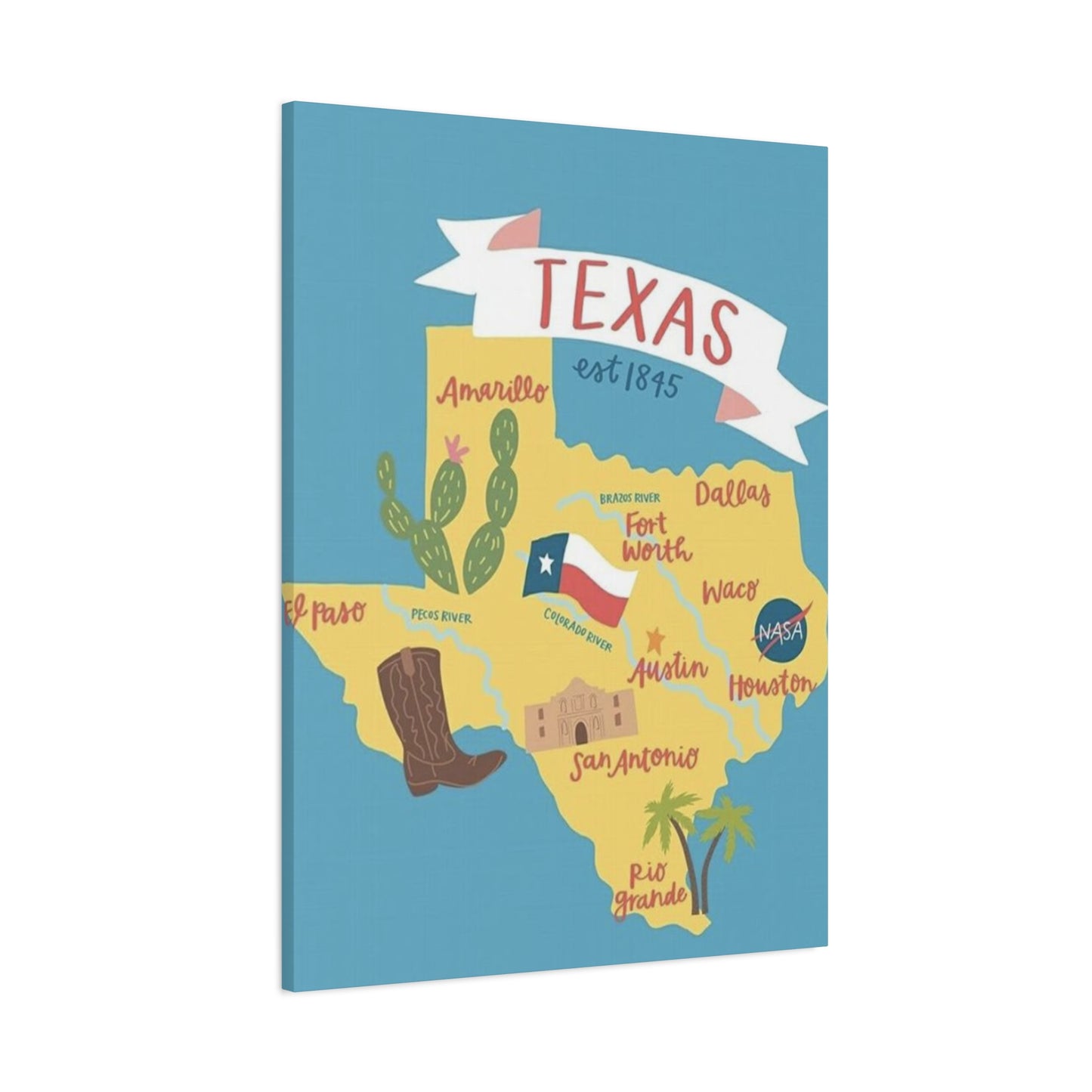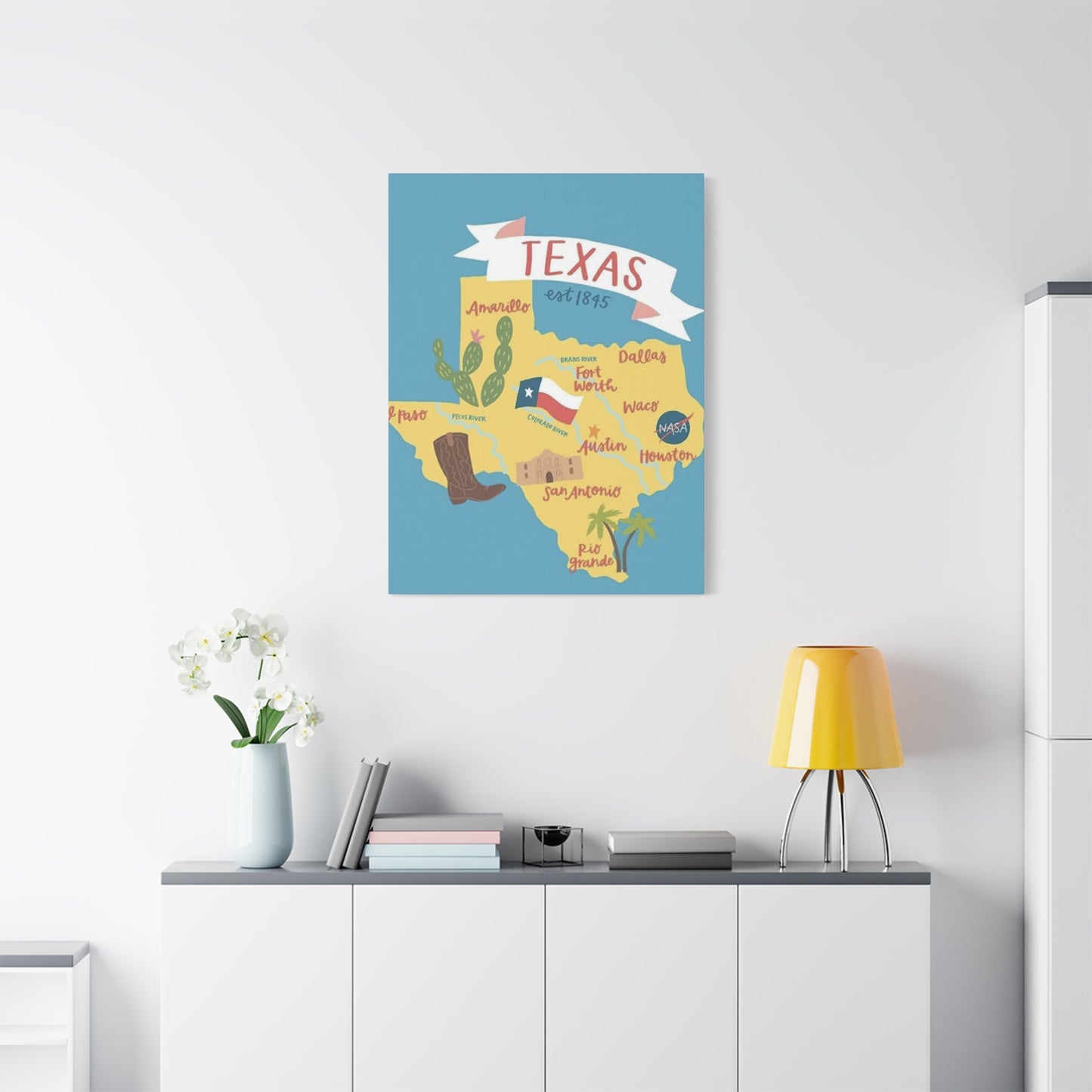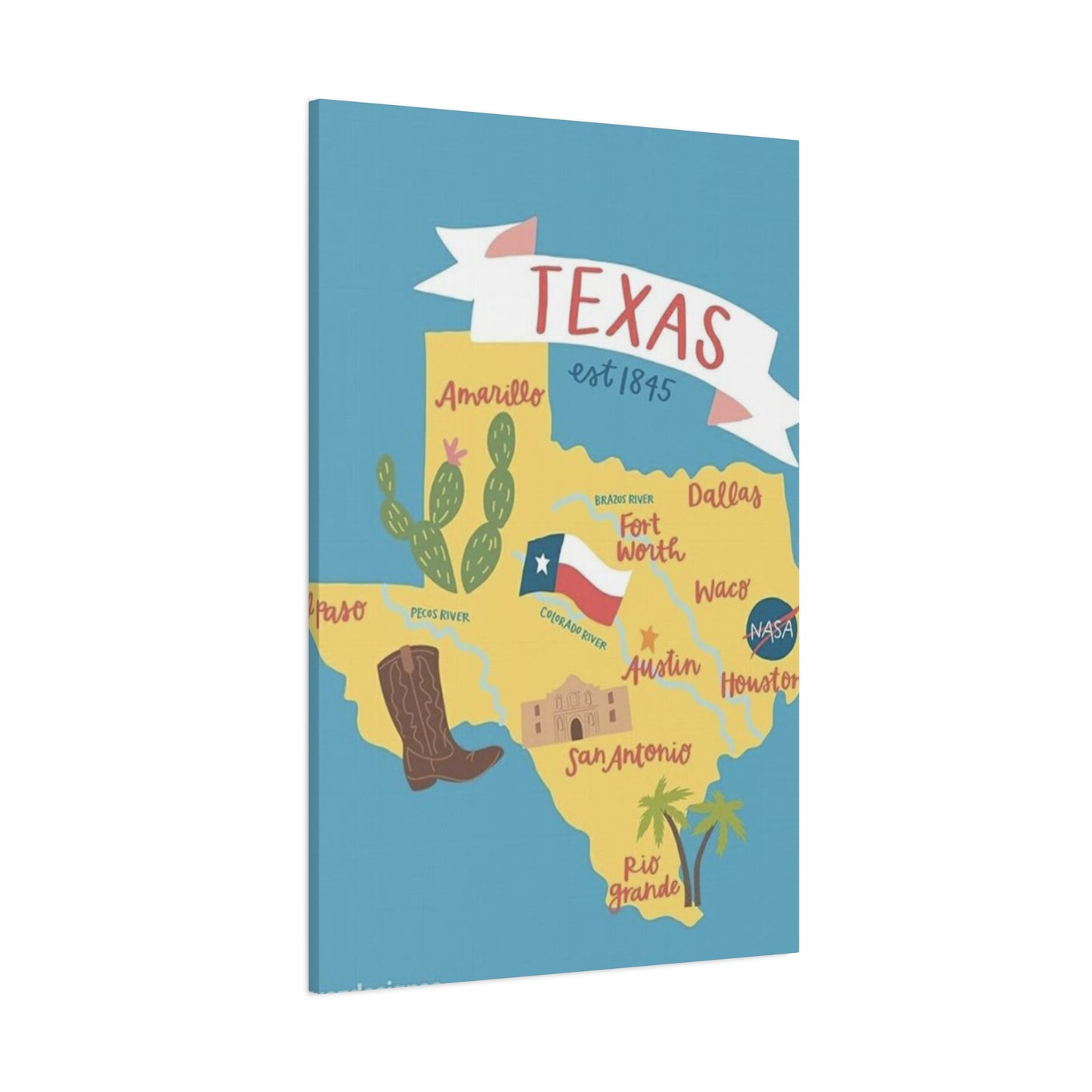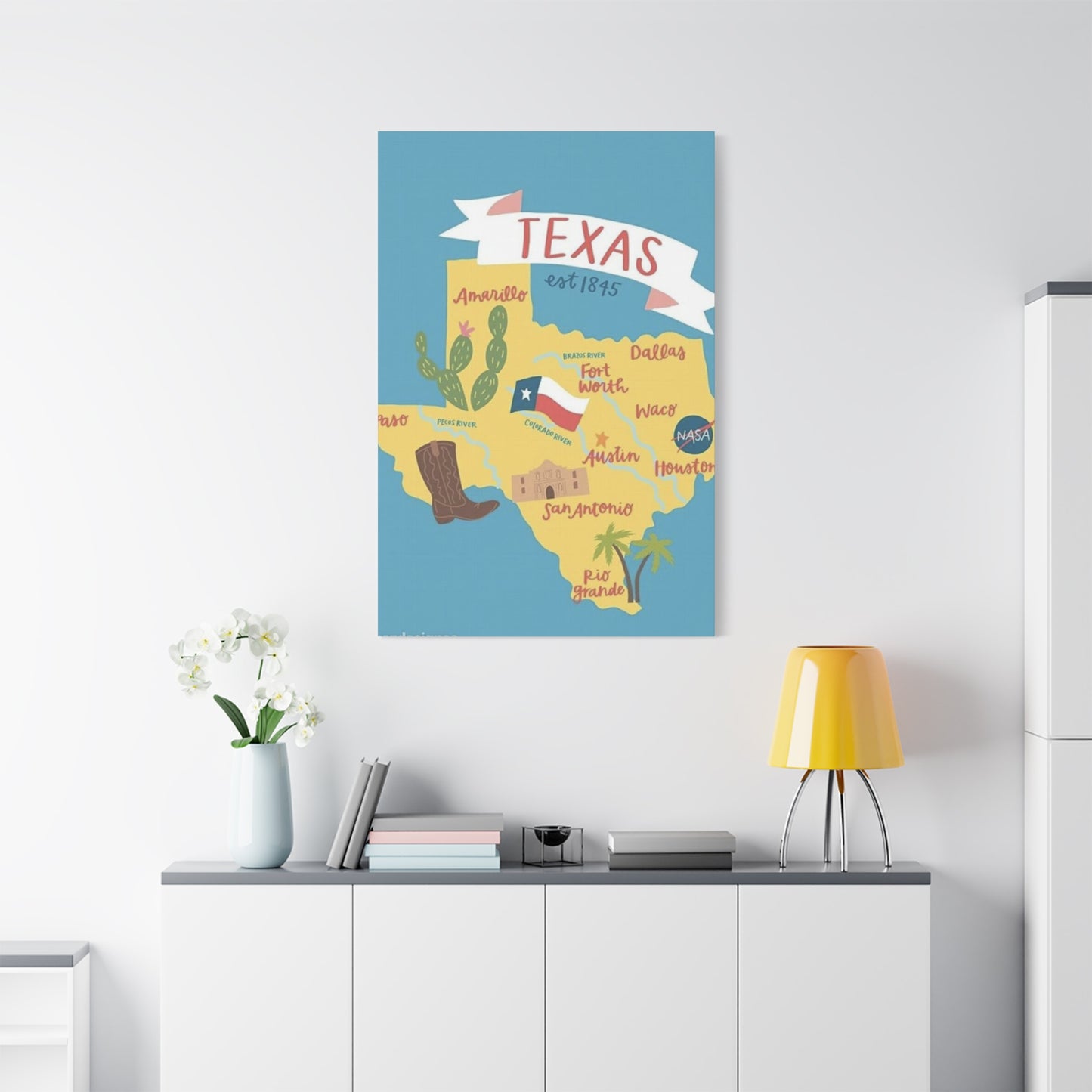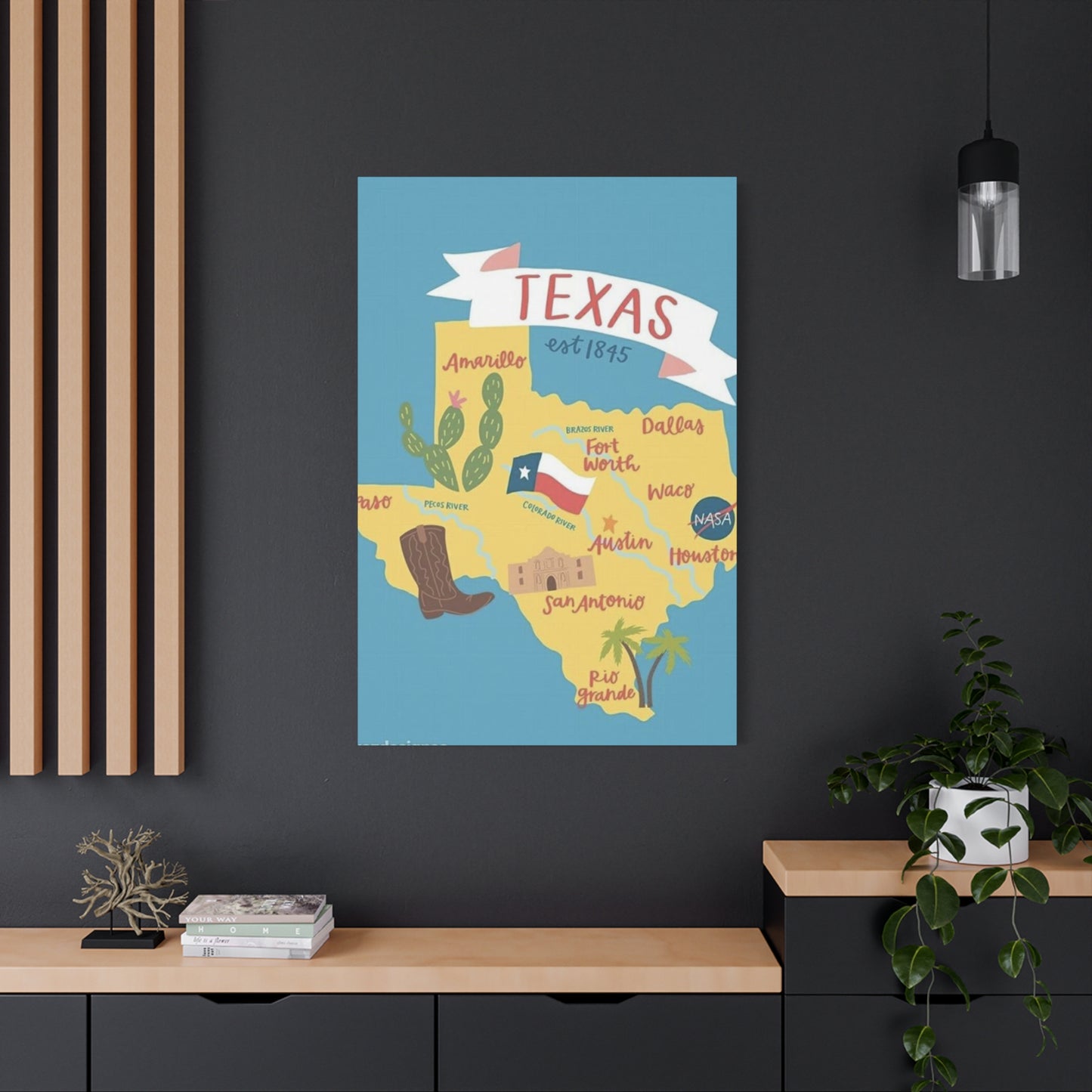Lone Star Legacy: The Enduring Charm of Texas EST 1845 Poster Wall Art
In the vast world of home decor, few items carry the weight of history, identity, and regional pride quite like a Texas EST 1845 poster wall art. This is not merely a piece of paper or canvas meant to fill an empty space on a wall; it is a declaration. It is a nod to a complex, storied past and a symbol of a culture that values resilience, independence, and a unique heritage. The simple inclusion of "EST 1845" transforms a simple decorative item into a historical marker, a conversation piece, and a powerful emblem of identity. For those with ties to the Lone Star State, whether by birth or by choice, this specific piece of art resonates on a level that few other designs can.
It captures the spirit of Texas—a spirit born from a distinct history as a republic and its eventual, pivotal entry into the UnitedS. This artwork serves as a constant reminder of that legacy, blending rustic charm with profound meaning. As we explore the facets of this iconic decor, we delve into why a simple date combined with the state's name has become such an enduring and popular statement piece for homes, offices, and spaces that aim to capture a touch of the Texan soul. It's an aesthetic choice that is deeply rooted in a narrative, one that continues to captivate and inspire.
The Potent Symbolism of "EST 1845"
The four digits "1845" are the heart of any Texas EST 1845 poster wall art. They are not arbitrary; they represent a specific and monumental moment in American and Texan history. This date, December 29, 1845, marks the day that the Republic of Texas was formally annexed by the United States, becoming the 28th state in the Union. To understand the power of this date, one must first appreciate what came before it. Texas was not simply a territory that was settled and organized into statehood. It was its own independent nation—the Republic of Texas—from 1836 to 1845. This period of sovereignty, earned through revolution and conflict, forged a fierce and unique identity that persists to this day.
The "Lone Star" on the state flag is a direct symbol of this time as an independent republic. Therefore, "EST 1845" signifies more than just an establishment date. It represents a transition, a deliberate choice by the people of Texas to join the United States, bringing with them their distinct culture, history, and vast territory. When this date is emblazoned on wall art, it serves as a proud acknowledgment of this entire narrative. It encapsulates the grit of the Alamo, the victory at San Jacinto, and the unique political journey of a nation becoming a state. This poster is not just celebrating statehood; it is celebrating the singular path Texas took to get there. It is a distilled symbol of a legacy that is larger than life, making the artwork a piece of historical narrative as much as it is a decorative element.
The Magnetic Pull of Texan-Themed Decor
There is an undeniable allure to Texan-themed decor, a magnetic pull that has made it a popular aesthetic far beyond the state's borders. This style taps into a rich vein of American identity, one associated with the frontier, rugged individualism, and a warm, rustic hospitality. A Texas EST 1845 poster wall art is often a cornerstone of this aesthetic. The appeal lies in its ability to evoke a specific feeling. It suggests a connection to the land, to a simpler time, and to a culture of strength and endurance. This decor style is not just about state pride; it is about embracing a set of values. The materials often associated with it—reclaimed wood, distressed metal, warm leathers, and natural fibers—all contribute to a sense of authenticity and comfort.
A vintage-style Texas poster fits seamlessly into popular interior design trends like modern farmhouse, rustic industrial, and eclectic bohemian. It can act as a bold focal point in a minimalist room or blend harmoniously into a gallery wall filled with personal history. The "Texas" brand itself is globally recognized, synonymous with concepts like "big," "bold," and "independent." By displaying a piece of Texan-themed decor, a homeowner is borrowing a piece of that powerful narrative. It becomes a statement piece that communicates a personality, a set of interests, or a personal connection to the state's romanticized and rugged image, making the space feel both personal and profoundly American.
Integrating Your Texas EST 1845 Artwork
Incorporating a Texas EST 1845 poster wall art into your home is a straightforward way to add character and a sense of history to a space. The versatility of this art piece allows it to function beautifully in a variety of rooms and settings. In a living room, it can create a powerful focal point when hung above a mantelpiece, a console table, or a leather sofa. Paired with neutral tones, natural wood, and warm textiles, it can anchor the room and infuse it with a rustic, welcoming ambiance. For a more modern take, a minimalist black-and-white version of the poster in a sleek, simple frame can provide a graphic punch without overwhelming the space. In a home office or study, this artwork serves as a sophisticated nod to heritage and resilience. It can hang behind a desk, offering a backdrop of inspiration and strength.
Another popular location is the entryway or mudroom, where it acts as a bold statement of welcome, immediately setting a tone of grounded hospitality for all who enter. It can also be a perfect addition to a gallery wall, surrounded by family photos, landscape art, or other meaningful prints. The key to successful integration is considering scale and framing. A large, oversized poster makes a dramatic statement, while a smaller, more subtle print can add a touchof character to a bookshelf or a small nook. The frame itself—be it rustic barnwood, industrial metal, or classic black—will further define the piece's role within your existing decor, allowing it to either blend in or stand out.
Exploring Mediums and Artistic Interpretations
The term "poster wall art" has evolved far beyond simple paper prints. Today, a Texas EST 1845 poster wall art can be found in a diverse range of mediums and artistic styles, allowing for a high degree of personalization. The classic choice, a high-quality paper print, remains popular for its affordability and the ease with which it can be framed. Matte finishes offer a subdued, vintage feel, while glossy finishes provide a sharper, more modern look. For a more substantial and elevated presence, a canvas print is an excellent option. Canvas adds texture and depth, giving the artwork a more "fine art" appearance. Gallery-wrapped canvas, where the image extends around the edges, needs no frame at all and provides a clean, contemporary aesthetic.
A particularly popular medium for this theme is wood. The "EST 1845" design can be printed directly onto planks of reclaimed wood, with the natural grain and imperfections of the wood showing through. This creates an authentically rustic and one-of-a-kind piece that perfectly complements farmhouse or industrial decor. Metal prints offer another striking alternative. Printing the design on a sheet of aluminum gives it a high-definition, luminous quality with a sleek, modern edge, which can create an interesting contrast with the historical subject matter. Beyond mediums, the artistic interpretations vary widely. Some designs are purely typographic, focusing on bold, distressed, or elegant fonts. Others incorporate imagery like the Lone Star, the state flag, a map of Texas, or a silhouette of a longhorn, blending text and icon into a single, powerful composition.
A Statement of Heritage and Personal Identity
Beyond its function as a decorative object, a Texas EST 1845 poster wall art is, for many, a profound statement of heritage and personal identity. For a native Texan, it is a badge of honor. It is a connection to their roots, a tangible symbol of the state's unique and proud history that they learned about in school and that shapes the culture around them. It is a way of saying "this is where I am from, and I am proud of it." The fierce independence associated with the Republic of Texas is a core part of the Texan identity, and this artwork is a direct link to that spirit. For those who have moved to Texas, displaying this art can be an act of adoption. It signifies an embrace of their new home, an acknowledgment of its deep-seated culture, and a desire to be part of its ongoing story.
It is a way of planting a flag and declaring, "I am a Texan now." But the art's appeal is not limited to those who live within its borders. For Texans living "abroad" in other states or countries, it is a powerful piece of home. It's a cure for homesickness, a constant reminder of where they came true from, and a symbol of the values they carry with them. In any context, this piece of art tells a story about the person who displays it. It says they value history, they appreciate a culture of resilience, and they are connected to a legacy that is bold, independent,and larger than life. It is a piece of their personal narrative hung on the wall for all to see.
Selecting Your Ideal Texas EST 1845 Wall Art
Choosing the perfect Texas EST 1845 poster wall art for your space involves more than just finding a design you like; it requires a thoughtful consideration of context, scale, and material to ensure the piece achieves the desired effect. The first factor to consider is the room's existing decor. Is your style modern and minimalist, or is it rustic and cozy? A design with clean lines and simple typography in a sleek black frame will suit a contemporary space, while a distressed print on reclaimed wood will feel right at home in a farmhouse-style living room. The material of the artwork, as explored earlier, will heavily influence its "vibe." A canvas print feels more permanent and artistic, a metal print feels industrial, and a paper print offers flexibility. Next, consider scale and proportion. A common mistake is choosing art that is too small for the wall.
A large, empty wall, such as the one above a sofa or a king-sized bed, demands a substantial piece of art. An oversized poster or a large canvas can anchor the room and make a confident statement. Conversely, a small hallway, a bathroom, or a kitchen nook might be the perfect place for a smaller, more intimately-scaled print. Think about the color palette. Many of these posters come in neutral tones—black, white, cream, or sepia—making them easy to integrate. However, some may feature the bold red, white, and blue of the Texas flag, which would need to be balanced with the other colors in your room. Finally, consider the specific message and style. Do you want a purely typographic design, or one that includes the state map or flag? Each variation tells a slightly different story. Taking the time to weigh these factors will help you select a piece that not only looks beautiful but also feels like a true and fitting extension of your home's personality.
The Enduring Legacy of a Date and a Design
To conclude, the journey into the world of Texas EST 1845 poster wall art reveals an item that is far more than the sum of its parts. It is not just ink on a medium; it is a cultural artifact, a piece of distilled history, and a powerful symbol of a deeply ingrained identity. The enduring appeal of this specific design rests on its brilliant simplicity. The state's name, "Texas," carries an almost mythical weight, evoking images of wide-open spaces, rugged cowboys, and an unshakeable spirit of independence. The date, "EST 1845," grounds this myth in a specific, verifiable historical moment. It is the pivot point where the lone-star nation officially joined the larger American narrative, yet did so on its own terms, bringing its unique and sovereign past with it. This duality is what makes the art so compelling. It is both American and distinctly, defiantly Texan. In a home, this piece of art acts as a storyteller. It tells a tale of revolution, of a republic, and of a proud people. It imbues a room with a sense of place and a connection to a legacy. It moves beyond being a mere trend in interior design and becomes a timeless emblem.
Trends fade, colors go out of style, and furniture is replaced, but the story of 1845 is permanent. The values it represents—resilience, heritage, and pride—are values that people consistently seek to surround themselves with. This artwork serves as a constant, quiet reminder of those very things. It can be a source of inspiration in a home office, a statement of welcome in an entryway, or a warm, historical anchor in a living room. For those with Texan roots, it is a piece of their heritage. For those who simply admire the Texan spirit, it is an aspirational symbol. Its versatility in medium, from rustic wood to modern metal, ensures that this historical marker can find a place in virtually any home, bridging the gap between a storied past and a contemporary present. The Texas EST 1845 poster wall art is, therefore, not just decor; it is a celebration of a story, a testament to an identity, and a lasting piece of the American mosaic. It is a simple, elegant, and powerful way to state that history matters, that roots are important, and that the spirit of the Lone Star State is alive and well.
1845 Bringing Lone Star Heritage
The year 1845 marks a pivotal moment in American history when Texas joined the Union as the 28th state, forever cementing its place as a symbol of independence, resilience, and unwavering spirit. For those who carry deep affection for the Lone Star State, commemorative wall art featuring the establishment date serves as more than mere decoration—it represents a connection to a rich legacy of courage, determination, and pride that continues to resonate through generations. These artistic pieces transform ordinary walls into statements of identity, celebrating the distinctive character that makes Texas unlike any other place in the nation.
Decorative prints bearing the 1845 establishment date have surged in popularity among residents and admirers of Texas alike, offering an elegant way to honor the state's admission to the Union while enhancing interior spaces with meaningful visual elements. Whether displayed in living rooms, offices, bedrooms, or communal areas, these pieces serve as constant reminders of the values and history that define Texan culture. The appeal extends beyond native Texans to include anyone who appreciates the state's contributions to American history, its cultural vibrancy, and its enduring mythology as a place where independence and self-reliance reign supreme.
The artistic representations of Texas's statehood year come in countless styles, from minimalist modern designs to elaborate vintage-inspired compositions, ensuring that every preference and decorating scheme can be accommodated. Some feature bold typography set against backgrounds in the state's iconic colors, while others incorporate maps, state outlines, or symbols like the lone star that have become synonymous with Texan identity. The versatility of these pieces makes them suitable for various settings, whether adorning the walls of a ranch-style home in the Hill Country, a contemporary apartment in downtown Austin, or even spaces far beyond state borders where Texan expatriates wish to maintain a connection to their roots.
Beyond their aesthetic qualities, these commemorative pieces spark conversations and create opportunities to share the fascinating stories behind Texas's path to statehood. They invite viewers to reflect on the Republic of Texas era, the challenges faced by early settlers, and the bold decision to join the United States after nearly a decade of independence. For families with generational ties to the state, such artwork becomes a visual representation of their heritage, a way to pass down pride and knowledge to younger generations who might otherwise lose touch with their historical roots.
The craftsmanship behind quality establishment date prints varies considerably, with options ranging from affordable mass-produced posters to limited-edition fine art pieces created by skilled artisans. Materials include traditional paper prints, canvas wraps, metal signs with distressed finishes, and wooden plaques with engraved or painted details. Each medium offers distinct advantages: paper prints provide accessibility and easy replacement, canvas adds texture and depth, metal evokes rustic authenticity, and wood brings warmth and organic character. Selecting the right material depends on the intended location, existing decor, and personal preference regarding maintenance and longevity.
Decorating with Lone Star Legacy Posters
Introducing a Lone Star Legacy poster into your home is an exercise in storytelling. This type of wall art does more than simply occupy a blank space; it infuses the room with a distinct character, a sense of history, and a touch of rugged individualism. The true art of decorating with these pieces lies in their placement and the context you build around them. In a living room, a large-scale poster, perhaps a typographic texas est 1845 poster wall art, can serve as a powerful focal point. When hung above a primary element like a fireplace mantel or a worn leather sofa, it immediately anchors the room and sets a conversational tone. It pairs exceptionally well with natural materials; think of it surrounded by exposed brick, alongside a reclaimed wood console table, or complementing the warm tones of a cowhide rug. In this setting, the poster acts as a bridge between modern living and a storied past.
For a home office or a study, the poster's message of resilience and independence is particularly fitting. Placed in the line of sight behind a desk, it serves as a source of quiet inspiration, a reminder of strength and heritage during a long day of work. It can transform a sterile office into a personalized study with depth and soul. Another popular application is in the entryway or mudroom. Here, the poster becomes a bold statement of identity and hospitality, welcoming guests with an immediate sense of the home's personality. It sets the tone from the moment one walks in, suggesting a space that values roots and authenticity. Finally, incorporating a Lone Star Legacy piece into a gallery wall is a masterful way to personalize it. When juxtaposed with family photographs, landscape art of the Texas Hill Country, or abstract pieces, the poster's historical significance is balanced by your own personal narrative, creating a rich, eclectic, and deeply meaningful display.
The Iconic Symbols Behind Texas Poster Art
Texas poster art derives its immense power from a rich vocabulary of iconic symbols, each a piece of visual shorthand for a complex story of history and identity. These are not just random images; they are deeply encoded emblems that resonate with a shared cultural understanding. The most prominent, of course, is the Lone Star. This single star, which gives the state its nickname, is a direct and potent symbol of the state's former status as an independent nation, the Republic of Texas. It represents a fierce spirit of independence, a history of self-governance, and a unique political journey. When it appears on a poster, it is the primary marker of this proud exceptionalism. Another ubiquitous symbol is the very outline of the state itself. Instantly recognizable due to its unique shape and immense scale, the map of Texas has become an icon in its own right, signifying not just a geographic location but the idea of "bigness" and a distinct world within the United States. Then there is the historical date, such as that found on a texas est 1845 poster wall art.
This specific date is a symbol of a monumental transition, marking the moment the Republic of Texas was annexed and became the 28th state. It encapsulates the entire narrative of revolution, sovereignty, and its eventual strategic union. Other symbols play vital supporting roles. The longhorn steer, with its impressive horns and rugged nature, symbolizes the state's deep roots in cattle ranching, the frontier spirit, and the challenging cattle drives that forged a key part of its economic and mythological identity. More recently, the oil derrick has become a symbol of Texas's economic might, representing the 20th-century boom that transformed the state and the world. Even the state flower, the bluebonnet, serves as a symbol of natural beauty and resilience. When these elements are combined in a single piece of art, they create a layered narrative, allowing a simple poster to communicate complex ideas of independence, history, industry, and natural pride.
Lone Star Legacy: A Timeless Tribute to Texas
The "Lone Star Legacy" is more than just a catchy phrase; it represents the entirety of the cultural, historical, and mythological inheritance of Texas. A piece of wall art bearing this title, or embodying its spirit, serves as a timeless tribute to this complex identity. Its timelessness stems from the fact that it is not tied to a fleeting design trend, but to the very bedrock of the state's foundation. While interior design fads come and go, the story of the Alamo, the grit of the independent Republic, and the pride of its 1845 statehood are immutable parts of the American narrative. This art acts as a permanent marker of that story. A texas est 1845 poster wall art, for example, is a direct tribute to the pivotal moment of annexation, a celebration of the unique path Texas took to join the Union. This legacy is one of resilience. It pays tribute to the generations who carved a life out of a challenging frontier, who fought for their independence, and who built a globally recognized culture from the ground up.
Displaying this art is a way of honoring that resilience, of keeping that spirit of determination and endurance alive within the home. Furthermore, the legacy is one of a "larger than life" attitude. Texas has always cultivated a mythology of scale—its vast landscapes, its big ambitions, its bold personalities. This art captures that spirit. It is a tribute to the idea that anything is possible, a concept forged in the wide-open spaces of the West and the gushing oil fields of the 20th century. This art endures because the values it represents—independence, strength, pride, and heritage—are themselves timeless. It appeals across generations, connecting grandparents who lived by these codes with younger generations who admire the authenticity and bold aesthetic. It is a tribute that does not fade, precisely because the legacy it honors is still being written every day.
How Texas Posters Celebrate Statehood
Texas posters, particularly those that prominently feature the date "1845," are powerful commemorative items that celebrate the complex and unique story of its statehood. Unlike posters from other states, which might simply feature a founding year, a Texas poster referencing 1845 tells a much more dramatic tale. It is not celebrating a simple organization of a territory; it is celebrating the conclusion of one of an independent nation and the beginning of a new chapter as part of the United States. This date, December 29, 1845, marks the day the Republic of Texas was formally annexed, becoming the 28th state. A poster that highlights this, such as a texas est 1845 poster wall art, is a direct celebration of this monumental political event. It celebrates the nine-year period of sovereignty that preceded it, a time when Texas was its own country with its own president, currency, and embassies.
The celebration, therefore, is layered. On one hand, it celebrates the end of a difficult and often precarious period of independence. On the other, it celebrates the unique terms of its entry into the Union, coming in as a nation, not a territory, and retaining control of its public lands. These posters serve as historical markers, reminding the viewer that Texas's place in the United States was a matter of international treaties and deliberate choice, not a simple administrative process. In this way, the art celebrates the state's enduring sense of exceptionalism. It is a visual declaration that Texas joined the Union on its own terms, bringing with it a fierce identity that was already fully formed. When someone displays this art, they are not just celebrating a state; they are celebrating a former nation and the singular, unparalleled history of its transition to statehood. It is a celebration of a legacy that is truly unique among all fifty states.
Vintage Texas Art: Why Retro Posters Are Popular Again
The recent resurgence in popularity of vintage Texas art and retro-style posters speaks to a collective longing for authenticity and tangible history in a fast-paced, digital world. These posters, often characterized by distressed textures, muted color palettes of sepia and faded blues, and classic serif or bold san-serif typography, feel like artifacts from a different era. This nostalgic aesthetic is a significant part of their appeal. They evoke a romanticized vision of the past—the rugged frontier of the Old West, the booming optimism of the mid-century oil rush, or the simple, bold graphics of early 20th-century advertising. This sense of nostalgia provides comfort and a feeling of connection to a time perceived as simpler and more authentic. Furthermore, the visual style of retro posters aligns perfectly with several dominant interior design trends.
In the modern farmhouse aesthetic, a distressed texas est 1845 poster wall art on reclaimed wood feels perfectly at home, adding a layer of historical character. In industrial-style lofts, the raw, graphic nature of a vintage-style metal sign or poster complements the exposed brick and metal fixtures. Even in minimalist or contemporary spaces, a retro Texas poster can act as a striking, soulful counterpoint, adding a splash of warmth and personality that prevents the room from feeling sterile. These pieces are popular because they are imbued with "character." A crisp, modern print might look clean, but a vintage-style poster feels as though it has lived a life; its faux-fading and texturing tell a story before you even read the words. This perception of a storied past makes the artwork more than just decoration; it becomes a conversation piece, a small window into a history that feels both rugged and romantic.
Lone Star Legacy: Perfect for Texan Home Decor
The concept of the "Lone Star Legacy" is the beating heart of traditional and modern Texan home decor, and wall art that embodies this theme is arguably the most essential element for achieving this specific aesthetic. Texan decor is built on a foundation of warmth, rustic comfort, proud heritage, and a "come on in" sense of hospitality. A poster celebrating this legacy, whether it’s a stylized texas est 1845 poster wall art or a design featuring the Lone Star, serves as the perfect anchor for this style. It immediately communicates the core values of the home. This type of art is a perfect fit because it harmonizes beautifully with the material palette of Texan design. The ruggedness implied by the state's history is mirrored in the materials that define the style: rich, worn leathers, rough-hewn wooden beams, wrought iron light fixtures, and natural stone fireplaces.
A poster with a vintage, distressed look feels as though it belongs in this environment, as if it has been part of the home's story for generations. Conversely, in a more modern Texan home—think a sleek condo in Austin or Dallas—a minimalist, typographic poster celebrating the Lone Star Legacy can provide a sophisticated, graphic nod to heritage. In a black-and-white print with a simple frame, it bridges the gap between contemporary design and historical pride. What makes this theme so perfect is its versatility. It can be the central, commanding piece in a grand living room, or a subtle, personal touch in a study. It provides an instant sense of place and identity, which is the ultimate goal of regional decor. It is a way of stating, "This home is grounded in a proud history," making it an indispensable tool for anyone looking to create an authentic Texan-inspired space.
Texas Pride in Poster Form: A Cultural Exploration
The phenomenon of Texas pride is a unique and potent cultural force, often viewed by outsiders as a form of "exceptionalism." This intense identification with the state is rooted in its singular history, and poster art is one of the most accessible and popular mediums through which this pride is expressed. A cultural exploration of Texas-themed posters reveals them to be more than mere decorations; they are declarations of identity, badges of allegiance to a cultural narrative. The primary source of this pride is, without question, the state's history as the Republic of Texas. No other state in the Union was an independent, sovereign nation before joining. This fact is the wellspring of a distinct identity that sees Texas as a partner in the United States, rather than just a subordinate part. Posters that reference this history, such as a texas est 1845 poster wall art, are not just historical markers; they are celebrations of this unique status.
They are a way for individuals to align themselves with this narrative of independence and self-sufficiency. Furthermore, Texas pride is deeply intertwined with a "mythology" of the self-made individual—the rugged cowboy, the wildcatter who strikes it rich, the resilient frontiersman. Poster art distills this complex mythology into powerful, simple symbols like the longhorn, the oil derrick, or the state's vast, open landscape. Displaying such a poster is an act of participating in that myth. It is a statement that the owner identifies with, or at least admires, the values of grit, individualism, and ambition. In poster form, this pride becomes a tangible, visual, and public statement. It is a way to claim heritage, whether one is a multi-generational native or a new resident who has "come to Texas as fast as they could." These posters are cultural artifacts, the everyday flags of a people who, perhaps more than any other, view their state identity as central to their personal one.
The Evolution of Texas Wall Art
The evolution of Texas wall art is a fascinating journey that mirrors the state's own transformation from a rugged frontier to a modern, economic, and cultural powerhouse. The earliest forms of Texas art were, naturally, focused on the landscape. Artists in the 19th and early 20th centuries were captivated by the state's unique and challenging environment, giving rise to the iconic "bluebonnet painters" who sought to capture the fleeting beauty of the Hill Country in spring. This era was defined by representational art: grand landscapes, dramatic scenes from the Alamo, and portraits of the cattle drive, all aimed at documenting and romanticizing the state's foundation. As Texas entered the 20th century, particularly with the oil boom, its art began to change. While rustic themes remained popular, the state's growing wealth and urban centers like Houston and Dallas fostered a new wave of modernism.
Art became more abstract, though still often inspired by the immense, flat horizons and the industrial geometry of oil fields. This period saw Texas art begin to look inward, exploring not just what the state looked like, but what it felt like. The "cosmic cowboy" movement of the 1970s, centered in Austin, represented another shift—a playful, counter-cultural, and self-aware take on Texas mythology. Today, evolution has led to an incredible diversity of styles. The rustic landscape painting still thrives, but it now coexists with bold pop art, sophisticated minimalism, and the powerful rise of typographic art. This modern minimalist trend is where pieces like the Texas est 1845 poster wall art find their place. These posters distill the complex history and bold identity of Texas into a clean, graphic, and design-forward statement. This evolution shows that Texas wall art is no longer just about depicting a landscape; it's about curating an identity, allowing residents to choose the piece that best represents their personal connection to the state's multifaceted story, from its historic past to its contemporary cool.
Framing the Lone Star: Decorating with Texas Posters
The act of decorating with Texas posters is only complete once the crucial decision of framing has been made. The frame is not a passive border; it is an active component of the design that fundamentally alters the poster's message and style, effectively "framing" the Lone Star legacy itself. The choice of frame is what tailors a popular piece of art to a specific interior and a personal taste. For instance, take a classic texas est 1845 poster wall art. Placed in a thick, rustic frame made of reclaimed barnwood, the poster's historical message is amplified. The distressed wood grain and rough texture complement the vintage feel, making the piece a perfect fit for a modern farmhouse, rustic, or traditional Texan decor scheme. It feels grounded, authentic, and "of the land." Now, take that exact same poster and place it in a simple, thin black or white gallery frame.
The effect is immediately and dramatically different. The poster is transformed into a piece of modern graphic art. The clean lines of the frame create a contemporary, minimalist aesthetic, making it suitable for a sleek city apartment or a modern, uncluttered office. The focus shifts from rustic nostalgia to a bold, typographic statement. For a more industrial or masculine feel, a dark steel or brushed metal frame works exceptionally well. This choice highlights the "grit" and industrial power of Texas history, pairing well with exposed brick or concrete elements. The decision to include a mat is equally important. A wide, bright white mat creates "breathing room" around the poster, elevating it from a simple print to a piece of "fine art." It adds a layer of sophistication and formality, drawing the eye inward. Conversely, a full-bleed frame, where the poster extends to the very edge, creates a more immediate, bold, and immersive effect. Thus, "framing the Lone Star" is the final, critical step in decorating, allowing the homeowner to interpret and present their Texas pride in a way that is perfectly in tune with their personal style.
Texas History Through Poster Art
Poster art serves as an exceptionally powerful and accessible medium for exploring the rich, dramatic tapestry of Texas history. Unlike a dense textbook, a well-designed poster can distill a complex event or an entire era into a single, resonant image or phrase, making history both visible and personal. A curated collection of historical Texas posters can, in effect, create a visual timeline that tells the state's story chapter by chapter. The narrative could begin with posters referencing the "Come and Take It" cannon of Gonzales or the defiant stand at the Alamo. These pieces are not just decorations; they are visual representations of the revolutionary spirit and the concept of sacrifice for independence that are foundational to the Texan identity. Following this, a poster dedicated to the Republic of Texas (1836-1845) encapsulates the nine-year period of sovereignty. This is where a texas est 1845 poster wall art becomes a crucial storytelling element.
It serves as the bookend to that era, the pivotal moment of transition when the lone-star nation became the lone-star state. This single print tells a story of diplomacy, national identity, and the strategic decision to join the Union. The timeline would then move into the post-Civil War era, represented by art depicting the great cattle drives. Posters featuring the iconic longhorn or a stylized map of the Chisholm Trail would speak to the economic forging of the state and the creation of the American cowboy myth. The next major chapter would be the oil boom, visually captured by posters of the Spindletop gusher or the graphic silhouettes of oil derricks, symbolizing the state's 20th-century transformation into an global energy powerhouse. By displaying these pieces, one is not just decorating a wall; they are curating a museum of their own heritage, allowing art to serve as a constant, engaging reminder of the key moments that shaped the Lone Star State.
Lone Star Legacy: A Nod to Texas Heritage
The "Lone Star Legacy" is, at its core, a concept of heritage—a cultural, emotional, and philosophical inheritance passed down through generations. A piece of wall art that references this legacy is, therefore, a quiet but profound "nod" to this shared heritage. It is an acknowledgment of the values and stories that have shaped the Texan character. This heritage is, first and foremost, one of independence. This is not just a political stance but a personal one, a deeply ingrained value of self-reliance and individualism that stems directly from the state's history as a sovereign nation. A poster that features the Lone Star or the "EST 1845" date is a nod to that unique origin story, a way of saying, "We remember where we came from." It is also a nod to a heritage of resilience. The history of Texas is fraught with hardship, from the brutal fight for independence to the taming of a harsh and unforgiving frontier.
This has cultivated a "grit" and a "can-do" spirit that is a central part of the heritage. A simple, rustic poster on the wall serves as a reminder of this ancestral strength, a symbol of the ability to endure and overcome. Furthermore, this heritage includes a strong, almost codified, sense of hospitality. The state motto is "Friendship," and the legacy of "Texas hospitality" is one of welcoming neighbors and strangers with warmth and generosity. This art, in a way, is a nod to that tradition, contributing to a warm, grounded, and welcoming atmosphere in the home. When someone displays a texas est 1845 poster wall art, they are doing more than just hanging a decoration. They are participating in an ongoing tradition. They are giving a respectful nod to the ancestors, known and unknown, who built this legacy, and they are preserving that story for the next generation.
Personalizing Your Space with Texas Posters
Given the popularity of Texan-themed decor, a key challenge is making a common item like a Texas poster feel personal and unique to your own space. The secret to personalization lies not in the poster itself, but in its context. The art of making it "yours" is about curating the wall and the room around it to tell your specific story. The most effective method is to integrate the poster into a gallery wall that reflects your own life. When a texas est 1845 poster wall arta is placed next to a framed black-and-white photograph of your grandparents' ranch, a diploma from a Texas university, and a small, quirky piece of art from a local Austin artist, it is no longer a generic statement. It becomes one part of your larger, personal narrative. The poster's historical statement is amplified and grounded by your personal history. Another powerful method is through customization. While many posters are mass-produced, seeking out artists or shops that offer personalization can make a world of difference.
This could be as simple as a poster of the Texas map with a heart or star placed over your hometown, or a typographic design that incorporates your family's name and the year your family "established" its roots in Texas. This small change transforms the piece from a general tribute to the state into a specific tribute to your family's place within it. The context of the room itself also personalizes the art. A vintage Texas poster hanging in a room filled with guitars, amplifiers, and band posters tells a story about a love for the Austin music scene. That same poster in a room with bookshelves full of history, leather-bound classics, and antique maps tells a very different story of a person connected to the state's intellectual and political heritage. Ultimately, a Texas poster is a starting point. You personalize it by surrounding it with your life, your hobbies, your family, and your passions. This is how you take a shared symbol of pride and make it a unique reflection of your own identity.
Conclusion:
In conclusion, the Lone Star Legacy poster wall art is more than just a decorative piece—it’s a celebration of Texas’s rich history, pride, and enduring charm. Since its establishment in 1845, Texas has stood as a symbol of independence, resilience, and vibrant culture, and these qualities are captured beautifully in the imagery of the Lone Star. Whether displayed in a home, office, or community space, the Texas EST 1845 poster serves as a proud reminder of the state's legendary heritage and its deep connection to both its past and present.
The visual appeal of this wall art lies in its ability to blend nostalgia with modern flair. Bold and distinctive, the design often features the iconic Lone Star flag, historical motifs, or elements that embody Texas’s diverse landscapes—from its sweeping deserts and rolling plains to its bustling cities and rugged mountains. The combination of vintage typography and contemporary design creates a timeless aesthetic that fits effortlessly into a variety of décor styles, particularly in spaces where a sense of pride and personal identity is important.
For Texans, or those with a deep appreciation for the state's history, the Lone Star Legacy poster wall art can evoke feelings of unity, strength, and pride. It’s a perfect way to honor the Texas spirit, whether you’re a native or a fan of the state’s unique culture. The bold colors and iconic symbols tied to Texas's identity invite conversation and bring a touch of regional authenticity into any room.
Ultimately, the Texas EST 1845 poster not only captures the state’s historical significance but also represents the ongoing legacy of Texas’s diverse traditions, entrepreneurial spirit, and independent nature. It’s a powerful piece of art that resonates with anyone who appreciates the grandeur and heritage of the Lone Star State, serving as a lasting tribute to one of the most iconic states in the U.S. Whether in a home, a Texan-themed bar, or a local business, this piece of art adds character and pride to any space.


















